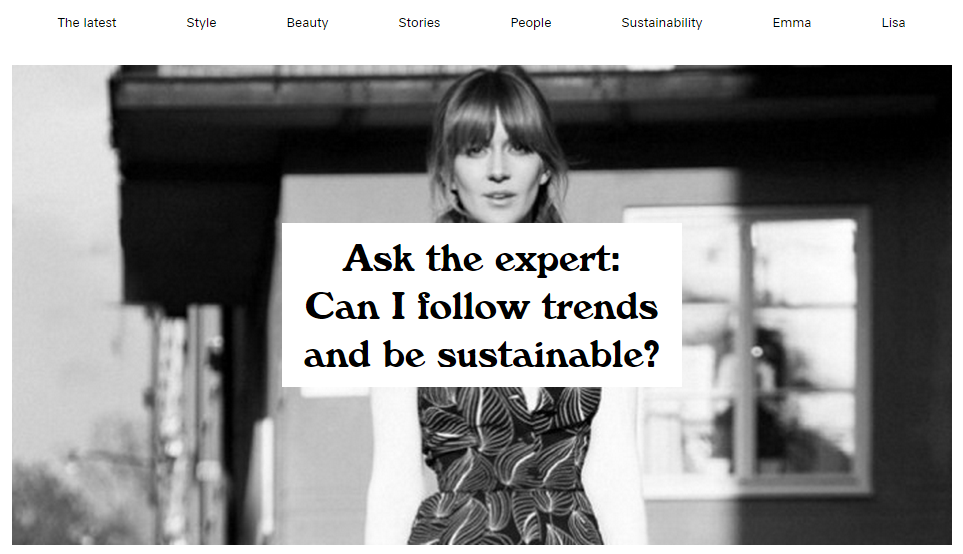
Make it last: Fashion can be both about following new trends and finding your own personal style. How do you think sustainability and fashion can be combined in this perspective?
Anna Brismar: Fashion consumers are becoming increasingly aware of the serious sustainability challenges facing today’s fashion industry, in terms of various environmental, social and ethical issues needing to be addressed on a global level. Yet, fashion consumers also seem to get keener to developing their own personal styles, and this latter trend actually rhymes with the development of more sustainable wardrobes. The reason hereof is that fashion consumers are beginning to see the various benefits of mixing different sources of fashion pieces; but such different sources of fashion may also constitute different forms of more sustainable fashion! (See image here.)
More specifically, fashion consumes are starting to blend and combine various fashion sources. For example, new eco-friendly garments (”Green & Clean”) are paired with second hand or vintage pieces, and rented or borrowed pieces (”Rent, Loan & Swap”) are matched with tailored or self-made items (”On demand or DIY”). To mend and redesign one’s favorite clothes has also become a more common phenomenon, representing another type of sustainability strategy (referred to by Green Strategy as “Remake, Repair & Upcycle”). On top of this, the concern for ethical issues within the fashion industry has also intensified over the last years.
Poor working conditions, low factory wages and violations of animal rights have been quite extensively debated in media, especially since the large factory accident at Rana Plaza in Bangladesh in April 2013, and now re-actualized through the Norwegian television series (Sweatshop – Deadly Fashion) about three young fashion enthusiasts who went to Cambodia to experience the actual working conditions in sweatshops first hand. To buy clothes made in an ethically responsible way now seems obvious to most people (referred to as ”Fair & Ethical”), although lack of transparency in supply chains remains a major obstacle.
For most fashion companies, certain sustainability strategies tend to be in greater focus than others. For example at Filippa K, “sustainability” has always been synonymous with long lasting fashion in both design and quality (referred to as ”High Quality & Timeless Design”). Nudie Jeans, on the other hand, has taken ”Repair” services to its heart. Houdini Sportswear has been using recycled polyester materials and offering ski outfits for rent for quite some time, while DEM Collective has embraced the concept of ”Green & Clean” since its start.
Perhaps in response to the growing interest in circular economy worldwide, forward-oriented fashion companies in Sweden are now opening up to new business models and sustainability strategies, including new customer services. For example, Filippa K now works towards a more circular business model, and as part of this effort, they recently launched a new rental service, a take-back scheme, and also presented their “Front Runners” collection, which consists of three pieces made of 100% renewable and natural Tencel fiber. Three new strategies of Filippa K towards more sustainable fashion!
Thus, while some fashion companies may still be hesitant to exploring new forms of sustainable fashion, consumers have every opportunity to test and embrace additional if not all seven forms! Thus, for your daily wear, you can quite easily pick a home-knitted scarf, a secondhand outerwear, a tailored blazer, a rented pair of pants, an environmentally friendly shirt (of organic cotton, Tencel or other more sustainable fiber), a pair of tights in recyclable Nylon, a borrowed pair of shoes, ethically made jewelry, and a timeless high quality bag. Mixing clothing, shoes and accessories in this way will probably be the most common way to build a more personal as well as sustainable wardrobe.
Approaching “sustainable fashion” simply as a wardrobe full of organic cotton or recycled polyester is no longer the case. Rather, a more sustainable wardrobe means developing your personal style and mixing your carefully selected favorites, may they be rented, borrowed, secondhand, vintage, remade, DIY, tailored, custom-made, ethically made, locally made, high quality, timeless, and/or environmentally manufactured. Mixing pieces in a responsible way and according to your own personal taste and style is now the way to go!
This article was written by Anna Brismar and originally published by Make it last on February 13, 2015. Republished here with permission.
(The photo at the top shows Emma Elwin wearing a vintage dress and top from Bruuns Bazaar. Source: makeitlast.se)
